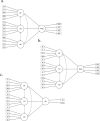Understanding the pathways to text generation: A longitudinal study on executive functions, oral language, and transcription skills from kindergarten to first grade
- PMID: 39729521
- PMCID: PMC12140084
- DOI: 10.1371/journal.pone.0315748
Understanding the pathways to text generation: A longitudinal study on executive functions, oral language, and transcription skills from kindergarten to first grade
Abstract
This longitudinal study explored the contribution of transcription skills, oral language abilities, and executive functions in kindergarten to written production in grade 1 among Spanish-speaking children (N = 191) through structural equation modeling (SEM). Three dimentions of written production were assessed, including productivity, quality, and syntactic complexity. Accordingly, three SEM models were tested to explore these relationships, and the estimated models for each endogenous variable demonstrated good fit. The results indicate that transcription skills and executive functions were key predictors of productivity, while both transcription and narrative oral competence contributed to writing quality. Syntactic complexity, on the other hand, was primarily influenced by narrative oral competence and executive functions. The results are interpreted within the framework of the not-so-simple view of writing model, particularly considering the characteristics of a shallow orthography. Limitations and educational implications are also discussed.
Copyright: © 2024 Jiménez et al. This is an open access article distributed under the terms of the Creative Commons Attribution License, which permits unrestricted use, distribution, and reproduction in any medium, provided the original author and source are credited.
Conflict of interest statement
The authors have declared that no competing interests exist.
Figures




Similar articles
-
How executive functions predict development in syntactic complexity of narrative writing in the upper elementary grades.Read Writ. 2017;30(1):209-231. doi: 10.1007/s11145-016-9670-8. Epub 2016 Jul 1. Read Writ. 2017. PMID: 28163388 Free PMC article.
-
Kindergarten Predictors of Third Grade Writing.Learn Individ Differ. 2015 Jan 1;37:27-37. doi: 10.1016/j.lindif.2014.11.009. Learn Individ Differ. 2015. PMID: 25642118 Free PMC article.
-
The contribution of executive functions to narrative writing in fourth grade children.Read Writ. 2015;28(7):989-1011. doi: 10.1007/s11145-015-9558-z. Read Writ. 2015. PMID: 26190902 Free PMC article.
-
Relating transcription, executive functions and text quality in Grades 2-3: A cross-lagged panel analysis.Br J Educ Psychol. 2023 Jun;93(2):482-499. doi: 10.1111/bjep.12570. Epub 2022 Dec 5. Br J Educ Psychol. 2023. PMID: 36471660
-
The relationship between oral and written narratives: A three-year longitudinal study of narrative cohesion, coherence, and structure.Br J Educ Psychol. 2015 Dec;85(4):551-69. doi: 10.1111/bjep.12091. Epub 2015 Sep 16. Br J Educ Psychol. 2015. PMID: 26373247 Review.
References
-
- Yeung P.S., Ho CSh., Chan DWo., & Chung KKh. Contribution of oral language skills, linguistic skills, and transcription skills to Chinese written composition among fourth-grade students. Discourse Processes, 2013. 50(7), 498–529. doi: 10.1080/0163853X.2013.841070 - DOI
-
- Hayes J.R. Modeling and remodeling writing. Written Communication, 2012. 29(3), 369–388. doi: 10.1177/0741088312451260 - DOI
-
- Longobardi E., Spataro P., & Pizzicannella E. Handwriting, spelling, and narrative competence in the fictional stories of Italian primary-school children. European Journal of Psychology of Education, 2018. 33(2), 277–293. doi: 10.1007/s10212-017-0328-y - DOI
-
- Arfé B., Dockrell J.E. & De Bernardi B. The effect of language specific factors on early written composition: the role of spelling, oral language and text generation skills in a shallow orthography. Read Writ, 2016. 29, 501–527. doi: 10.1007/s11145-015-9617-5 - DOI
MeSH terms
LinkOut - more resources
Full Text Sources

